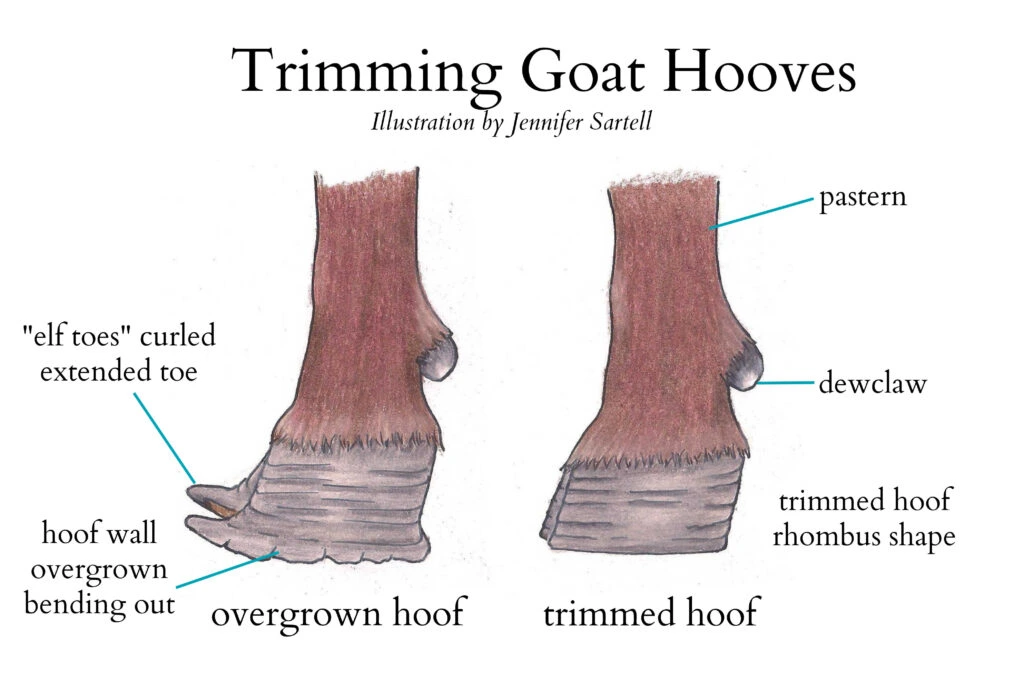
Hoof rot is a common challenge for goat owners, especially in damp or humid conditions. This painful hoof infection can cause lameness and discomfort, impacting your goats’ overall well-being. The good news is that with a holistic approach – focusing on natural prevention and gentle management – you can keep your herd’s hooves healthy and rot-free. In this post, we’ll break down what hoof rot is and share natural strategies to prevent and manage it so your goats stay happy on their feet. [Comment: Rephrased the introduction to set a clear, upbeat tone and context for the reader]
Understanding Hoof Rot in Goats
Hoof rot (also known as foot rot) is a bacterial infection that affects the soft tissue between a goat’s hooves. It typically thrives in wet, muddy environments where bacteria can infiltrate the hoof. Goats with hoof rot may show signs like limping, reluctance to walk, a foul odor from the hoof, or visible separation of the hoof wall. Understanding these warning signs and the conditions that cause hoof rot is the first step in combating it. By recognizing why hoof rot occurs – moisture and bacteria working together – you’ll be better prepared to fight it.
Natural Prevention Strategies
Preventing hoof rot naturally revolves around maintaining a clean environment and bolstering your goats’ hoof health from the inside out. Here are key strategies to keep hoof rot at bay:
-
Keep Living Areas Dry and Clean: Moisture is hoof rot’s best friend, so turn it into an enemy. Ensure your goats’ pens and pastures have good drainage and dry areas for them to stand. Use gravel or wooden pallets in high-traffic spots and refresh bedding regularly to avoid manure buildup and mud. By reducing prolonged moisture exposure, you create an environment where rot-causing bacteria struggle to survive.
-
Routine Hoof Trimming: Regularly trim and inspect your goats’ hooves (ideally every 4–6 weeks). Trimming prevents overgrowth that can trap mud and bacteria, and it lets you catch any developing issues early. A smooth, properly trimmed hoof has fewer nooks for bacteria to hide in. Make hoof checks a routine part of your goat care – your quick attention can stop a minor issue from becoming hoof rot.


-
Foot Baths with Natural Solutions: Periodic foot soaks can do wonders for prevention. Consider setting up a natural foot bath for your herd to walk through, especially during wet seasons. A common holistic choice is a zinc sulfate solution foot bath (a natural mineral foot soak) which helps kill bacteria and harden the hoof. You can also use a mild apple cider vinegar and water solution as a foot rinse – vinegar’s acidity creates an unfriendly environment for bacteria. Encourage goats to step through these solutions on their way in or out of the pen. It’s an easy, chemical-free way to disinfect hooves before rot can take hold.
-
Quarantine New or Affected Animals: When bringing in new goats, check and trim their hooves and, if possible, give them a preventive foot soak. Isolate new arrivals for a few days to ensure they aren’t carrying hoof rot into your herd. Similarly, if a goat does develop hoof rot, separate it from the others until healed. This keeps the bacteria from spreading in wet areas where the herd walks.
-
Nutritional Support for Hoof Health: Strong hooves start from within. Make sure your goats have a balanced diet rich in essential minerals like zinc and copper, which contribute to hoof strength and integrity. Provide quality mineral supplements or a well-formulated loose mineral mix free-choice. You can also use herbal treats to give an extra boost. For example, Funk Fixer Bites from BiteMe! Herbal Goat Treats are enriched with zinc and supportive herbs that help strengthen hooves and bolster the immune system. By incorporating such natural supplements, you address any mineral gaps that could make your goats more prone to hoof issues.
Managing Hoof Rot Holistically
Even with the best prevention, you might encounter a case of hoof rot. A holistic management approach can treat the infection while keeping your goat comfortable:
-
Immediate Hoof Care: At the first sign of hoof rot, clean the goat’s hoof thoroughly. Gently trim away any decayed or loose hoof material around the infected area – this helps air it out and prevents bacteria from hiding under dead tissue. Take care not to trim too deeply; you just want to remove the affected outer portions and open up the area for treatment.
-
Natural Antiseptic Soaks: After trimming, soak the hoof in a natural antiseptic solution. A warm foot bath with Epsom salt (magnesium sulfate) can draw out infection and reduce swelling. Alternatively, a zinc sulfate foot soak (as mentioned for prevention) can be used at treatment strength – often a 10% solution – to actively kill the bacteria. Soak the affected hoof for about 15–20 minutes if the goat will tolerate it. You might need to confine the goat in a small tub or use a boot made from a section of inner tube to keep the solution around the hoof.
-
Herbal or Mild Topical Remedies: After soaking, you can apply natural antibacterial agents to the hoof. Many goat owners swear by tea tree oil or thyme oil diluted in a carrier oil as a gentle topical antiseptic; these essential oils have natural antimicrobial properties. Garlic is another natural remedy – a poultice of crushed garlic or garlic water spray can help, since garlic is known for its bacteria-fighting allicin compound. If you prefer a ready-made solution, look for herbal hoof creams or sprays containing things like tea tree, calendula, or zinc. These can be applied daily to the cleaned hoof to help eliminate infection. (Always ensure any product you use is safe for goats and follow the directions.)
-
Keep the Hoof Dry: After treatment, if possible, wrap the hoof with a breathable bandage or vet wrap to keep out dirt and moisture. Stabling the goat on dry bedding (like straw or wood shavings) for a day or two can also help the hoof stay clean and dry as it heals. Check the wrap and hoof at least once a day – re-clean, reapply your natural antiseptic, and re-bandage if it’s damp or dirty. This diligent care creates an optimal healing environment without harsh chemicals.
-
Support Recovery with Nutrition and Care: While the hoof heals, continue to support your goat’s overall health. Good nutrition is crucial now – ensure they’re eating well and perhaps give an immune-boosting herbal supplement. This is where those Funk Fixer Bites can come in handy again: the extra zinc and herbs support healing from the inside, reinforcing hoof regeneration and immune response. Make sure the goat has a stress-free, comfortable space to recover, with easy access to water and feed. A happy, healthy goat will heal faster.
-
Monitor and Consult if Needed: Holistic methods can be very effective for mild to moderate hoof rot cases. You should see improvement in a few days – less odor, reduction in lameness, and new healthy tissue beginning to grow. If the goat isn’t improving within a week or the condition worsens (for example, the infection spreads or the goat develops a fever), it’s time to consult a veterinarian. Severe hoof rot may require additional interventions like antibiotics or more advanced hoof trimming. There’s no harm in using a holistic-first approach, but always be willing to seek professional help if your goat needs it.
Conclusion
Preventing and managing hoof rot in goats is absolutely achievable with a thoughtful, natural approach. By keeping your goats’ living areas clean and dry, sticking to regular hoof care, and using gentle remedies, you tackle hoof rot at its roots – literally! Remember that consistency is key: small daily and weekly habits (like quick hoof checks and dry bedding) make a huge difference in hoof health over time. And don’t forget the power of nutrition: a well-fed goat with all the right minerals will naturally grow stronger, more rot-resistant hooves.
Holistic hoof health isn’t just about avoiding chemicals; it’s about caring for the whole goat. From the ground they walk on to the food they eat, every aspect plays a part in keeping those hooves in top shape. So equip yourself with these natural strategies and a bit of patience. With vigilant care and a proactive mindset, you’ll prevent most hoof rot cases before they even start – and confidently manage any that do pop up. Here’s to happy goats and healthy hooves, naturally! ✨

Leave a Reply